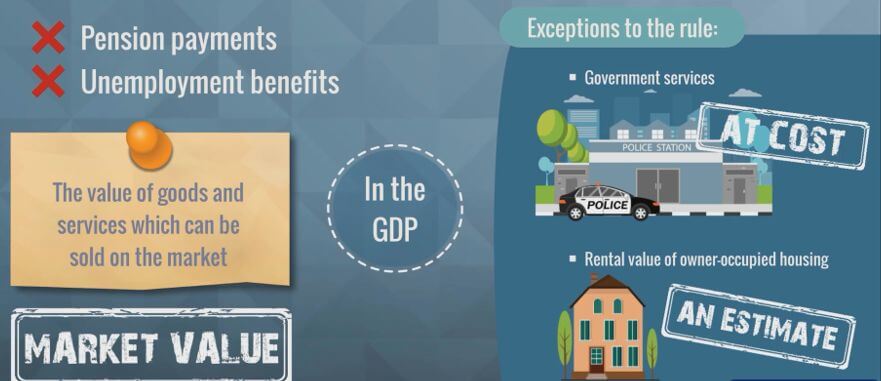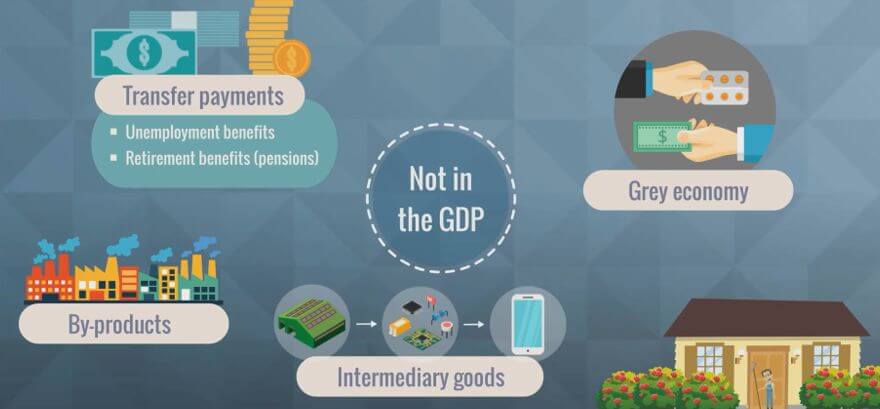What is Gross Domestic Product?
Join over 2 million professionals who advanced their finance careers with 365. Learn from instructors who have worked at Morgan Stanley, HSBC, PwC, and Coca-Cola and master accounting, financial analysis, investment banking, financial modeling, and more.
Start for Free
Gross Domestic Product (GDP) is one of the most widely used macroeconomic measures. It indicates the overall strength of a given economy. It primarily represents an economy’s size, growth, and, overall, the standard of living in a country.
What does GDP measure?
The Gross Domestic Product of a country is defined as the total market value of all goods and services produced in a nation within a given period of time. It is usually measured annually. The term “aggregate output” is often used interchangeably with GDP.
Note that the sales or resales of goods produced in previous years are excluded from the GDP figure.
Example: If Marilyn Monroe’s earrings were sold for $50,000 at a museum auction in 2015, this amount would not be part of the GDP for the year, because the earrings had been produced back in 1954.
Based on the purposes those serve, one may come across a few variations of the GDP measures, with nominal and real GDP being two of the more popular among them.
What’s included in the GDP figure?
The total amount of GDP is basically the sum of all goods and services produced in a country in a given year. If there is no economic output, no GDP is reported. However, this is a hypothetical situation and it cannot be observed in practice.
As a general rule, goods and services that can be bought and sold freely are included in the GDP total amount. You cannot sell pension payments or unemployment benefits on the open market, so we don’t add these up to the GDP figure.
Despite being non-tradeable per se, services provided by the government, such as police, school, and infrastructure improvements are also part of a country’s GDP. Although their market value cannot be determined, they are included in the total output produced by a country. As such, these services are valued at their cost of production, not at market price.
The third main component of GDP derives from the housing market. When you rent a place to live, the owners of the property receive rental payments. Such income takes part in the total GDP. So, the rental value of owner-occupied housing is included in the total output produced by a country.
When people own houses these are considered productive assets that generate economic benefits for society. Thus, “owned houses” need to be included in the nation’s GDP. However, as it is difficult to assess the market value of these assets, as most of them are not actively traded. Therefore, the rental value of owner-occupied housing is an estimated value of the total rental income that those assets would potentially generate for the economy.

What’s not included in the GDP figure?
There are certain components that are not included in the GDP figure.
Transfer payments, such as unemployment, retirement, and other types of benefits, are excluded from the calculation of GDP. They do not account for any specific goods produced or services rendered.
By-products of production, e.g. pollution, are excluded, too.
The same goes for intermediary goods. The value of semiconductors that a company buys to produce smartphones, for instance, would not be part of the GDP, given that it is used to create a finished good. Actually, the value of these intermediate goods is captured in the final price of products. So, total GDP takes into account the market value of final goods and services only produced in the given year only.
There are also certain services that are not included in the GDP measurement. For example, repairing your neighbor’s garden hedge is not an activity that qualifies as economic output.
Another example of economic activity that is excluded when calculating GDP relates to the grey economy, which refers to selling illegal goods or evading taxes.

The Takeaway
Gross Domestic Product refers to the monetary value of all finished goods and services produced in a local economy for a given year.
The three main components of the GDP figure are:
- the total production of a country in a given year
- the total value of services provided by the government
- the rental value of owner-occupied housing
By contrast, the items excluded from the GDP calculations are:
- transfer payments
- production by-products
- intermediary goods
- illegal activities
- and certain services
Understanding the GDP is the first step to properly analyzing the growth of an economy. If you want to find out more about the types of Gross Domestic Product calculations, read our articles on calculating GDP using the Expenditure approach and the Income approach.
Author: Antoniya Baltova, FCCA
